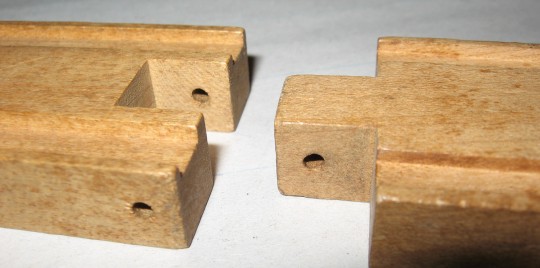
Mr. Pecota reports that his early 1940's set uses the grommet-style track, so it appears these pin-tracks are late 1930's, early 1940's.
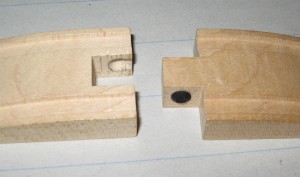
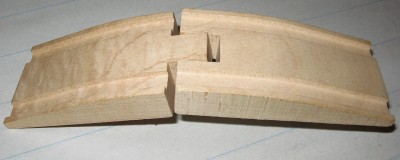
| Main
Train Page |
Buying |
Suppliers |
Historical
Trains 1 |
Historical Page 2 |
Thomas! |
Links Page |
Home Page |
Last Update: Oct
2009
Information
compiled by Doug A, e-mail: magicref@lycos.com
.
Special thanks go to:
Dave Pecota who has authored much
of the text on the history pages and provided many photos and research
information! Thanks, Dave!
Nero Matthias for the photos of
some of the Micki Trains from Sweden.
Sharon Nowlin who has been a source for many vintage toy catalogs and
advertisements that have helped document the history of these trains.
Sharon has an e-Bay store at: http://stores.ebay.com/Found-Treasures-by-Borzoi-Booklady
Judy's Old Wooden Toys: Toy articles and for sale: http://www.oldwoodtoys.com/
This History Pages are split into two pages because they are growing quite large. Covered here (so far) are:
|
Page 1: (This Page) Skaneateles Handicrafters
(Haba/T.C. Timber) |
Page
2: Keystone |
Through the years, Skaneateles Handicrafters (SH) trains could be found under other brand names. Playskool, in particular, carried the SH trains under their banner.
In 1980, Habermaass GmbH (of Germany) acquired the Skaneateles Handicrafters company and the train portion of the company changed their name to T.C. Timber. T.C. Timber trains are typically carried by high-end toy stores, and are not typically found in department stores. In 2003, Habermaas GmbH became known as HABA USA, a wholesale distributor of HABA, T.C. Timber, TOGU, and Spielstabil branded products.
Dave Pecota began writing me about some of the earlier Skaneateles Handicrafters trains (I'll call them SH trains from here on) that he had purchased. His interest sparked some additional research, and this page was the result! |
Initially, the track connectors used a pin method. This track
was
donated to me by Martin and is a very old sample of Skaneateles
Handicrafters track, probably from the early 1940's. Martin did
not have any of the
pin connectors, so at this point it is somewhat of a mystery as to what
the actual connectors looked like. Did the sets come with connectors,
or were kids expected to supply their own? Mr. Pecota reports that his early 1940's set uses the grommet-style track, so it appears these pin-tracks are late 1930's, early 1940's. |
| In the 1960's, the connectors were changed to a rubber grommet fitting. The male connector included a rubber grommet that provided a tension fit into the female connector. The track in these photos is from a 1968 Playskool set, and the grommets are still in good shape, although it is evident from the condition of the track and trains that this set was well taken care of. With rough play, I could see these connectors wearing out. |  |
| One of the unique features of this design is that you can raise the track without the connector coming apart, such as to go up a ramp. |  |
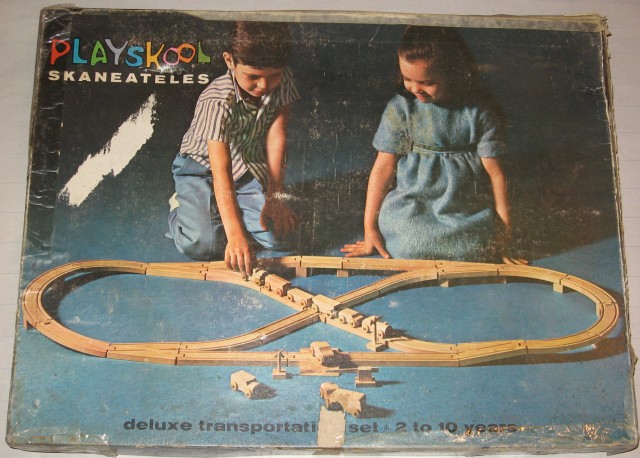
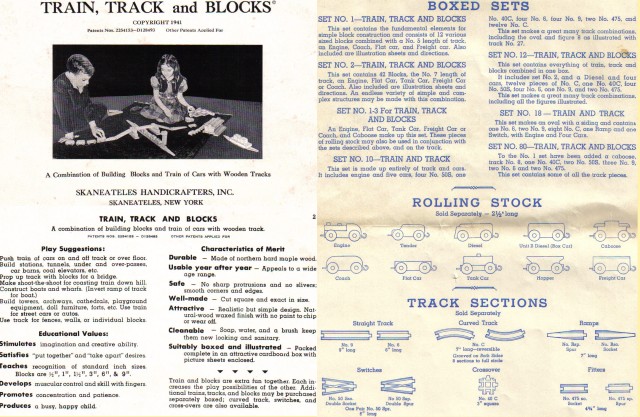
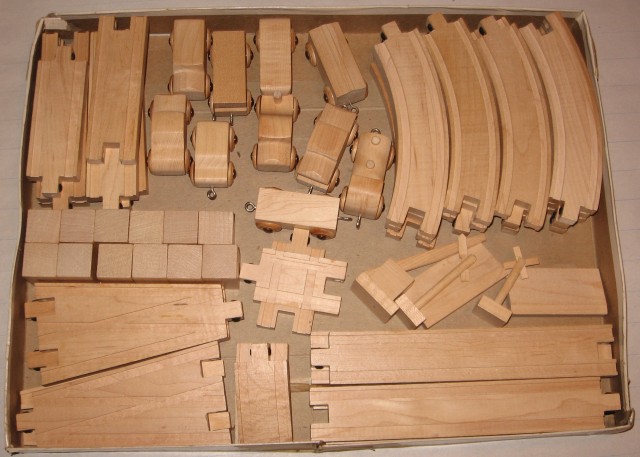
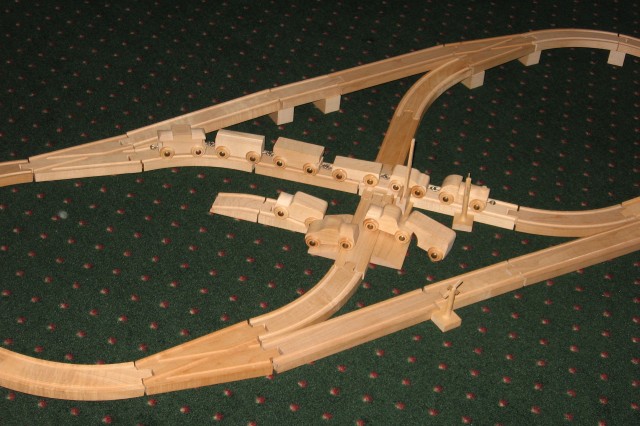
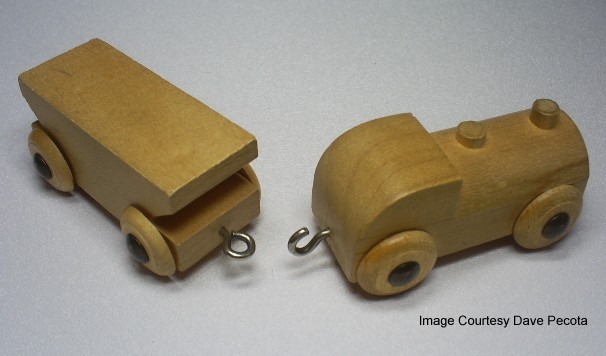 |
As you can see in this photo, SH trains used eye-hook connectors rather than magnets at this time period. The disadvantage is the capability of "poking" yourself with the hook connector, but the advantage is that the trains won't come apart when your are pulling an extra long train. Another disadvantage during playtime is that you can't disconnect the trains without lifting the train from the track. Current T.C. Timber trains now use magnetic couplers. |
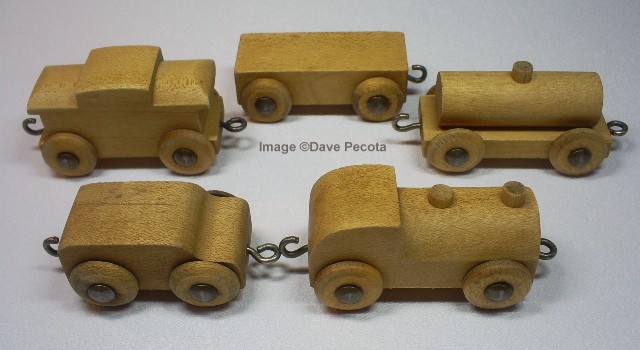 |
A nice set of older Skeneateles Handicrafters train cars |
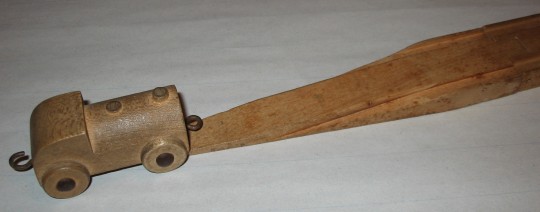 |
A neat ramp |
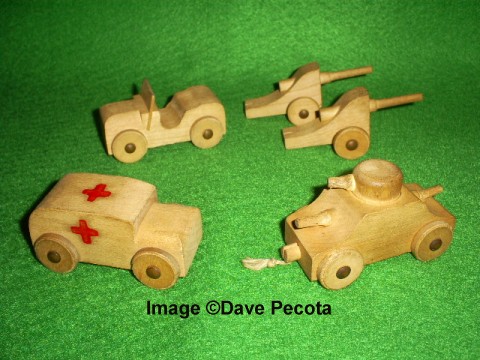 |
Okay, these aren't train
cars, but I had to include them as unique
models. Someone on e-Bay had written about another tank, "the very rare
item was the SH
WW2 armored car... SH needed govt approval to make it." |
TC TIMBER 2007: 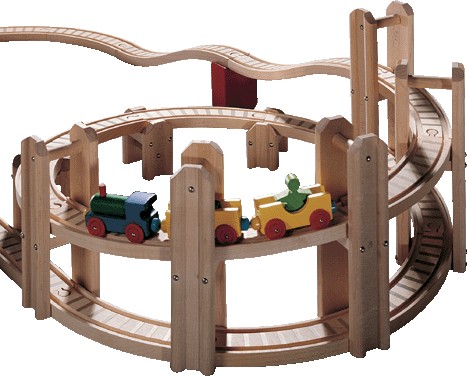 |
To the left is a more modern
"T.C. Timber" set - the Spiral. As you can see, they added more details
to the track to make it look more like real railroad track. Sadly, T.C. Timber has stopped manufacturing wooden trains (current Oct 2009). Although the train designs were plain, they had some clever track layouts, as can be seen in this photo from their catalog. |
The Jack Built Toy Manufacturing Company was very
active in
the wood toy train and track market during the 1950’s. Jack
Built was based in
Jack Built trains are similar in size and appearance to those produced by the Skaneateles Handicrafters of New York, but use novel (and patented) “snap” couplers to connect both trains and track
The little snap couplers allow trains to be connected or disconnected without removing them from the track. The couplers also provide enough “play” in the connections to allow the trains to easily negotiate corners and move up and down bridges and ramps, but are strong enough to prevent those frustrating “accidental” disconnects.
The track snap couplers utilized in the track sections provide some lateral and vertical movement in connecting track pieces. Double-sided curve track could have given the sets additional layout flexibility. However, Jack Built (B. Orel) wasn’t granted the patent for this type of track until 1961, and it’s unclear whether this modified track actually went into production. Jack Built wood train sets apparently disappeared from the marketplace about this time.
Jack Built used high quality hardwoods for their toy products. The sets were well-made and durable, and were designed for 2 to 10 year old children. Child safety was a high priority. As their catalog indicates, the sets provide “train fun that does not need adult supervision and eliminates the hazards of electricity”. Their product “educate(s) and develops the dexterity of the child through the use of shapes while arranging the parts in their proper position”.
Many educators seemed to agree, as many sets found their way into schools and child-care facilities all over the country. Some may be soldiering on in this capacity to this day.
Jack Built produced a wide variety of accessories for use with their sets including a water tower, trestle, tunnel, station platform, signal signs, telegraph poles and even a roundhouse with turntable. In addition, many different “road” vehicles were available including a gasoline tanker, double-deck bus, bulldozer, steamroller, semi-truck/trailer and dump truck. Wood blocks of various sizes and shapes were also included in many of the sets.
All of the trains, planes, boats, tracks and accessories appear to have been produced only in natural wood. None apparently were painted or received decorative paint details or stickers of any sort.
Jack Built trains and vehicles can be used with any Brio-compatible train set, but the unusual track couplers will not work with any other types of track.
In addition to their Snap Train, Snap Plane and Harbor sets, Jack Built sold a variety of toy products including crayons and “wipe-off” coloring books, wood looms and children’s books. Their sales literature indicates that Jack Built Toys was a division of Albin Enterprises. But both companies … or at least the company names … seemed to have disappeared from the toy product scene by the mid 1960’s.
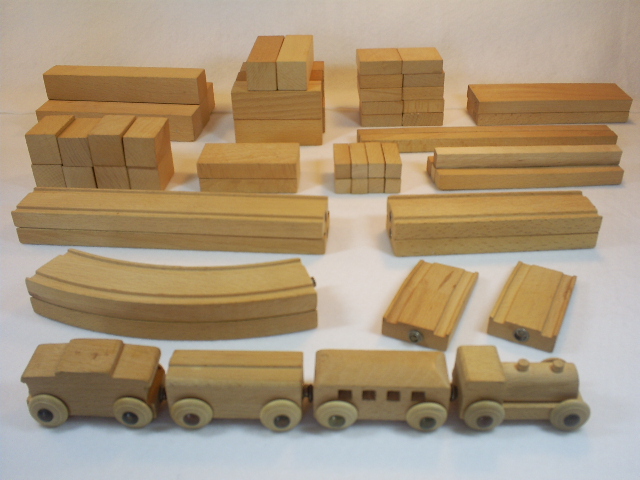
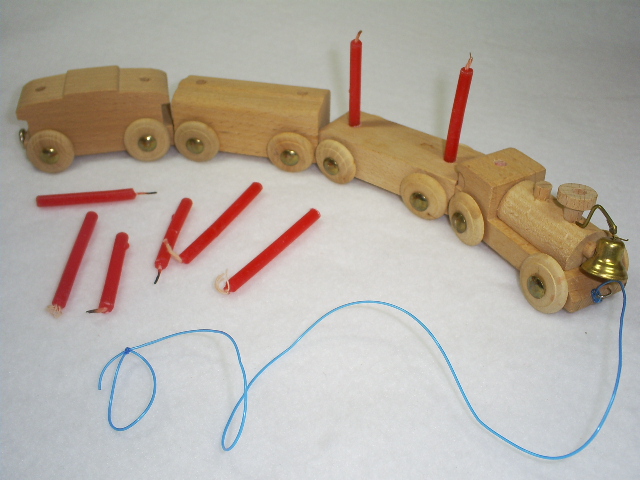
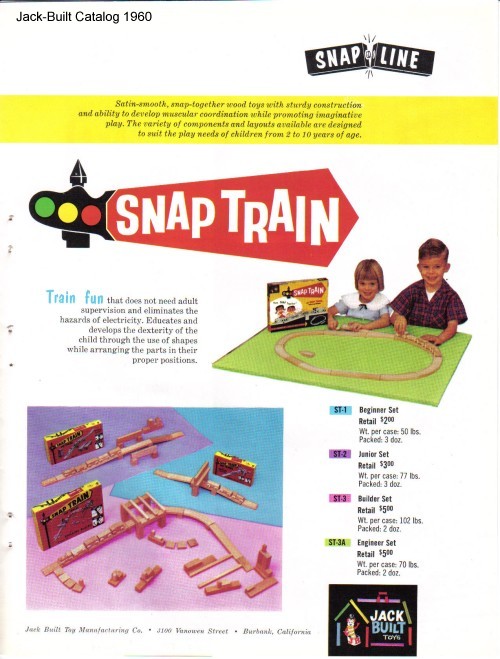
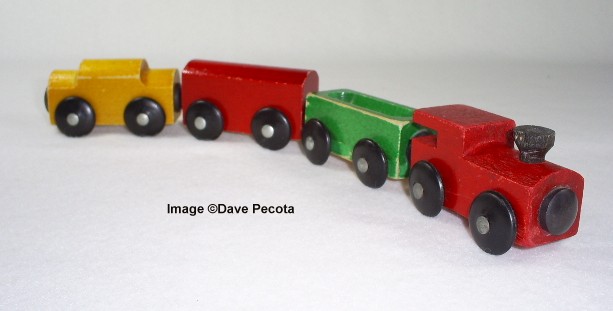
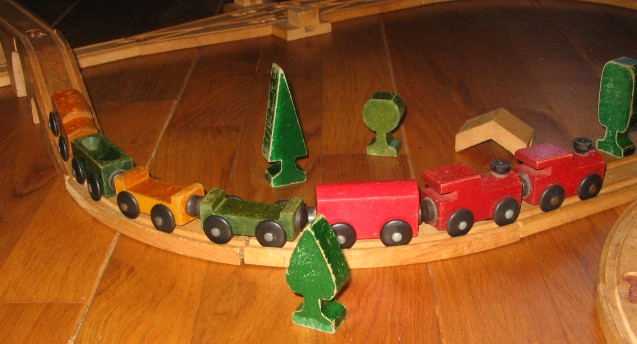
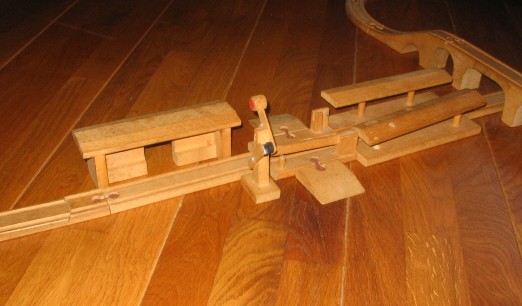
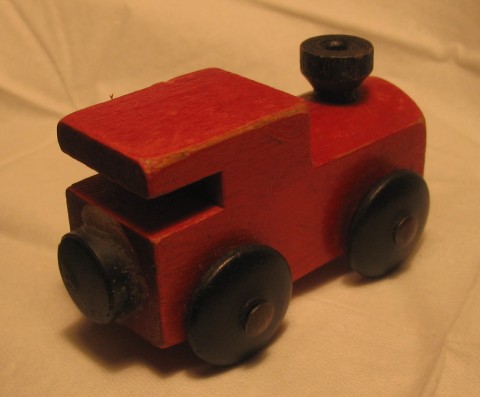
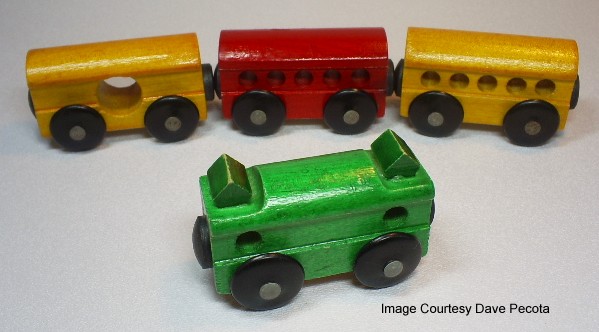

| Early
BRIO Trains. I don't know the specific dates of these trains, but as
you can see in the photo, they used hook and hook-eye connectors rather
than the magnetic connectors found today. |
 |
| This
is a set of 1960's era BRIO Trains that include both eye-hook
connectors and exposed magnets. I'm not sure what the use of the hook
on the front of the engine would have been since all the other cars
have magnetic couplers. It may have been so a child could tie a string
to the train for use as a pull train. |
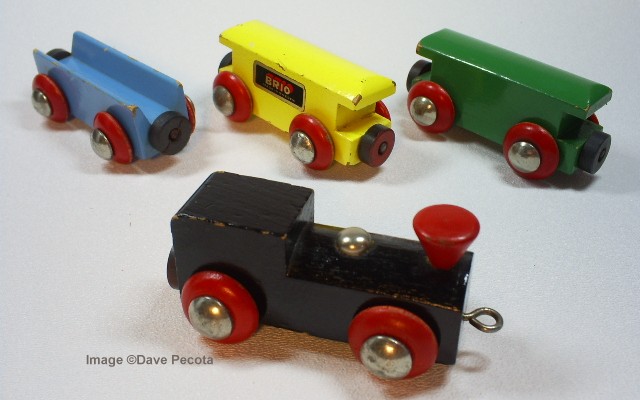 |
| Here
are a couple of sets from the 1980's. Notice the new version of the
magnets with metal tips rather than the exposed magnets in the set
above. The red BRIO engine to the right (from the mid-1980's) is a model of an electric engine. The bars across the top of the engine are the pantographs, which in a real engine connect it to the electrical signal, providing power to the train. |
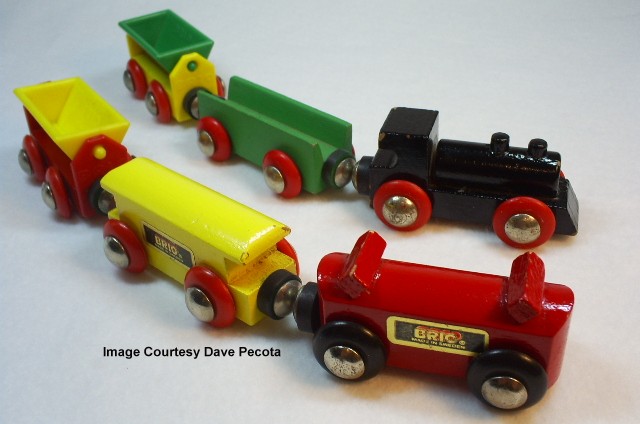 |
Yet another early BRIO... |
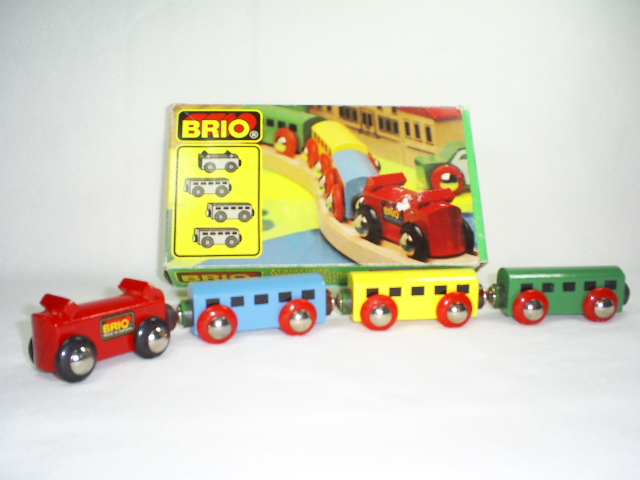 |
| Some BRIO vehicles from their 1999 Catalog, and below a few vehicles from the same era. In this period BRIO began to expand into minitature people characters. | 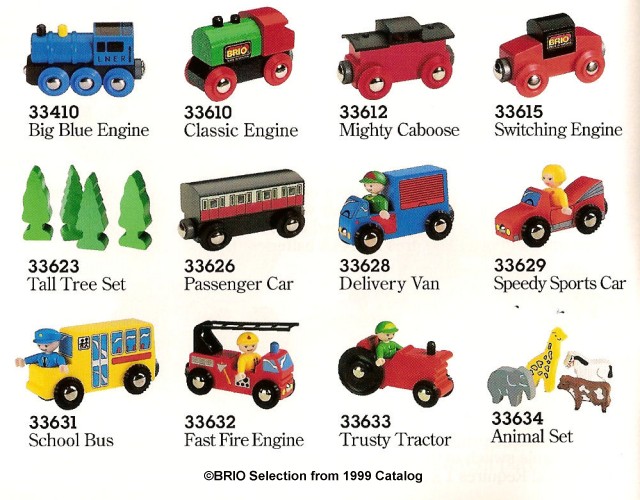 |
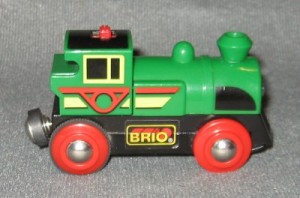 Note the use of more plastic rather than wood. The engine above is motorized, and the ambulence to the right makes a siren sound and the lights flash. |
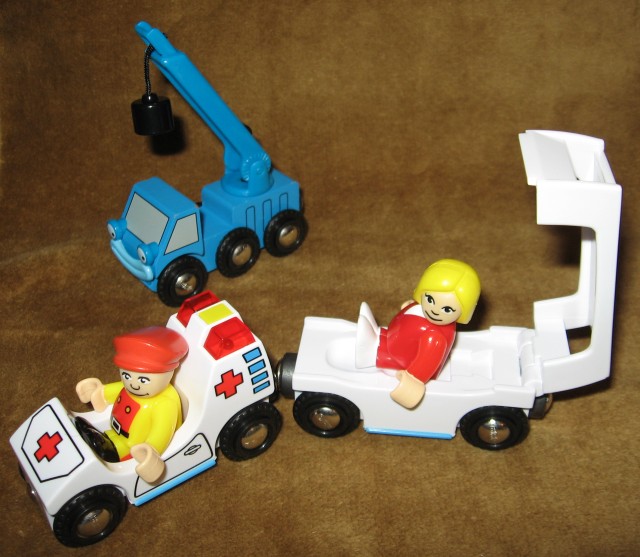 |